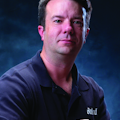Thermal Imaging: How Thermal Imaging Helps The Incident Commander
The job of an incident commander can be trying. Coordinating a scene full of firefighters, apparatus and other resources, often from multiple agencies, while performing a multitude of tasks in an environment where those decisions can make the difference between life and death is a lot to ask. Being responsible for the safety of everyone involved as well as the successful outcome of an often rapidly evolving and unpredictable incident would be enough to make most people consider doing something else.
The demands placed on an incident commander can be overwhelming; however, accurate, timely and reliable information is the backbone of most good fireground decisions, and your thermal imager can help with that. Your thermal imager can supply quite a bit of information that would otherwise be unavailable. Better yet, it can supply this information faster than just about any other means. Many departments have come to realize this benefit and are deploying thermal imagers in chiefs, battalion chiefs or deputy chief’s vehicles in an effort to make any and all pertinent information available to incident commanders.
I know what you are thinking: Why would an incident commander need a thermal imager? This column looks at various types of incidents at which a thermal imager can provide valuable information to the incident commander.
Structure fires
Using a thermal imager for scene size-up and assessment can give the incident commander additional information that is helpful in establishing the incident objectives. With the naked eye, you may see smoke coming from the eaves and the gable end of a single-story house, but when evaluated with the thermal imager, you can see much more. With the thermal imager, you may notice heat patterns on the outside of the structure. When you look to the roof, you may notice a strong heat signature (some portion of the roof being much warmer than other portions of the roof) to accompany the visible smoke. You realize that this structure would benefit from aggressive vertical ventilation; however, heat signatures like what you see before you take some time to develop, and we all know about gusset plates and heat exposure. Although it may take extra time, awaiting the setup of an aerial for ventilation purposes may be warranted.
The primary consideration in evaluating structures from the outside is the impact of the sun. If you are evaluating structures during daylight, you must account for the effect of sunlight. If the roof of the home is fully exposed to sunlight, yet you see a distinct pattern where parts of the roof are warmer than others, this is an indication (but not proof) of a fire in the attic area. If the pattern of sunlight closely matches the thermal pattern you see on the thermal imager, then the roof may simply be heated by the sun – an indication that the fire may not have vented to the attic yet.
Ventilation efforts can also be evaluated with a thermal imager. Whether vertical or horizontal, positive or negative pressure, with a thermal imager you can actually discern how much heat is coming out of the vent point as opposed to simply how much smoke is coming out. Abrupt changes to the amount of heat exiting a vent point also signal abrupt changes to the interior conditions as well.
Brushfire deployment
Brushfires can also be an ideal place for incident commander deployment of thermal imagers. Now, I am not talking about the type of wildland firefighting that our brothers and sisters deal with out west that requires air tankers. Although thermal imagers are useful in those incidents as well, that’s a topic for another column. I am talking about agricultural or suburban-type brushfires – the kind that occur in a department that owns one or two brush trucks, some water vests and a couple of those rubber mats tied to a broom handle. If you have ever been to soybean field fire just before harvest, you have seen what heavy smoke looks like.
Getting brush trucks to the larger fire areas and personnel to the smaller fire areas is essential. In situations like this, it is difficult for an incident commander to maintain an accurate operational picture. In a department where you have only two types of resources (brush trucks and people) that are both in limited supply, appropriate deployment is critical to a successful operation. Personnel accountability is also enhanced when the incident commander can see what is going on.
Limited visibility
An incident commander can also use a thermal imager simply to improve visibility at night and during inclement weather. Since the thermal imager does not use light to generate an image, it makes an ideal night vision tool. Picture quality is consistent and lets an incident commander generate a view of an entire scene that may not be possible otherwise, particularly when the scene is large or spread out. Visibility in rain or fog can also be enhanced through the use of a thermal imager. I think we all know how far a flashlight will get you in a heavy rain or dense fog.
Although these conditions will limit distance for a thermal imager, you can see farther in these conditions with a thermal imager than with any other technology you may have access to. How far an imager can see in these types of conditions is affected by quite a few factors, including density of precipitation and ambient temperatures, but if you work in an area prone to fog (eastern Tennessee comes to mind), a thermal imager can be a valuable tool for any incident.
Water rescue
Water offers a unique advantage to using a thermal imager in that it provides a consistent, isothermal background against which the imager can evaluate. Water, because it is a reflective surface for thermal imager, often looks artificially cold, which makes warm things really stand out. Locating, accessing and rescuing victims at night or during inclement weather, in static or moving water, is a good use for a thermal imager.
Victims are easier to locate and scene operations are easier to monitor when the incident commander is not relying on a shore-based spotlight. Positioned downstream from a swiftwater rescue, the incident commander can monitor operations as well as provide an important safety mechanism should a victim or rescuer be released into the moving water.
Conclusion
Although commonly overlooked, thermal imager deployment for incident commanders can add valuable information to the decision-making process, as well as provide a cohesive operating picture of the scenes they have been charged with orchestrating. When deploying a thermal imager for the incident commander, you may want to consider several accessory options, including digital zoom, given the greater distance at which the incident commander operates, tripod-mountable and some way to control screen glare.
Theodore Roosevelt once said, “The best executive is one who has sense enough to pick good men to do what he wants done, and self-restraint enough to keep from meddling with them while they do it.” Information is what keeps an incident commander comfortable in his or her command and reduces stress levels. It also is what keeps incident commanders at an appropriate distance and out of the way of scene operations, allowing them to exercise the necessary self-restraint.
BRAD HARVEY is the Thermal Imaging Product Manager at Bullard. He is a veteran of public safety as a firefighter, police officer and paramedic and is certified through the Law Enforcement Thermographers’ Association (LETA) as a thermal imaging instructor. Harvey has worked as a high-angle rescue instructor and is a certified rescue technician and fire instructor. If you have questions about thermal imaging, you may email him at [email protected].
About the Author
Brad Harvey
BRAD HARVEY is the Thermal Imaging Product Manager at Bullard. He is a veteran of public safety as a firefighter, police officer and paramedic and is certified through the Law Enforcement Thermographers’ Association (LETA) as a thermal imaging instructor. Harvey has worked as a high-angle rescue instructor and is a certified rescue technician and fire instructor. If you have questions about thermal imaging, you may e-mail him at [email protected].

